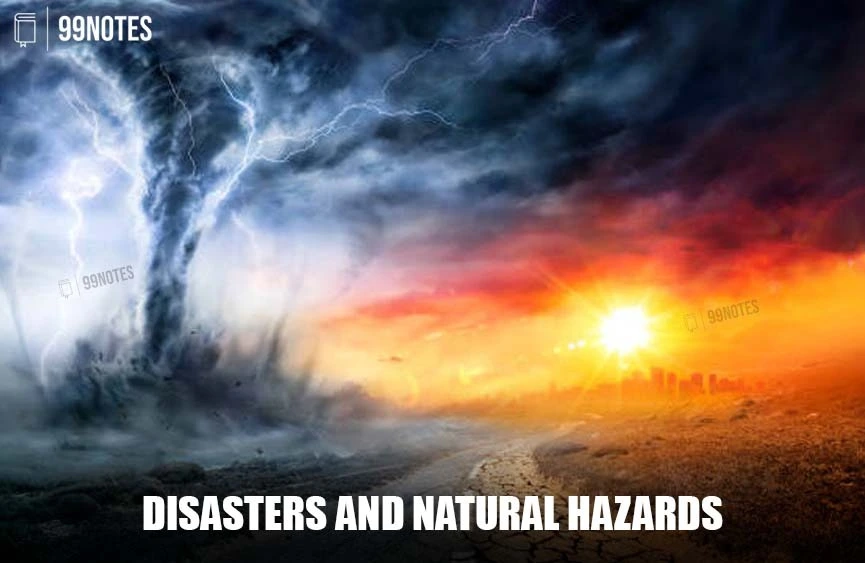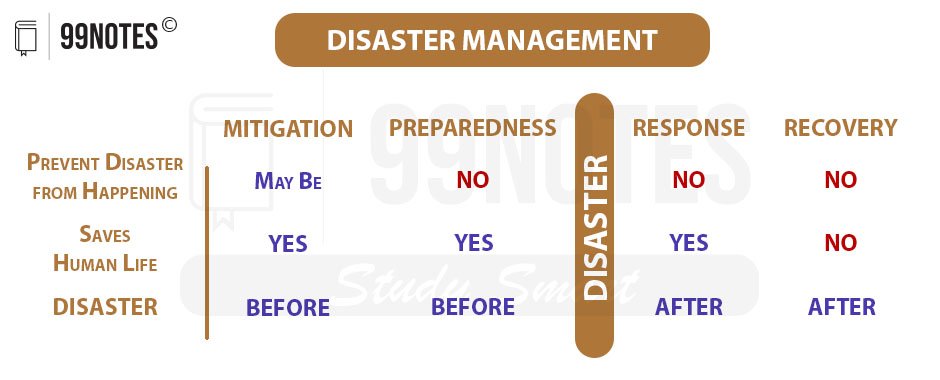Disasters and Natural Hazards
For a long time, Disasters were considered to be only natural and humans were considered victims – They were also caused by human activities; For example, the Bhopal Gas Tragedy, the Chornobyl nuclear disaster etc.
Some factors accelerate/intensify disasters indirectly: For example, the risk of landslides and floods increases due to deforestation.
Characteristics of a Disaster
Disasters are relatively sudden and cause large-scale, widespread death, loss of property and disturbance to social systems and life over which people have little or no control. Any event can be classed as a disaster when the magnitude of destruction and damage caused by it is very high.
Disasters are generalised experiences of people the world over. Every disaster is unique in terms of the local socio-environmental factors that control it, the social response it generates, and the way each social group negotiates with it.
Difference between Disaster and Hazard
A hazard is a potential for harm, while a disaster is the actual event that causes harm. Disasters are always caused by hazards.
Previously, hazards and disasters were seen as two closely associated and interrelated phenomena, i.e. areas prone to natural hazards, were more vulnerable to disasters. Hence, people avoided tampering with the delicate balance that existed in a given ecosystem.
Now technology has given the power to intervene in nature (such as by building better homes in landslide-prone areas). Consequently, human beings tend to intensify their activities in hazardous areas increasing their vulnerability to disasters.
For example, the Colonisation of flood plains, and the development of large cities and port towns like – Mumbai and Chennai along the coast – touching shores, making them vulnerable to the occurrence of cyclones, hurricanes and tsunamis.
Classification Of Natural Disasters
In a geographical sense, disasters can be classified as atmospheric, terrestrial, aquatic and biological.
| Atmospheric | Terrestrial | Aquatic | Biological |
| Blizzards, Hailstorm and Thunderstorms Lightning Tornadoes Tropical Cyclone Drought Frost, Heat Wave, Loo, Cold Waves, etc. |
Earthquakes Volcanic Eruptions Landslides Avalanches Subsidence Soil Erosion |
Floods
|
Plants and Animals as colonisers (Locusts, etc.) Insect infestation—fungal, bacterial, and viral diseases such as bird flu, dengue, etc. |
Disasters and Hazards can also be natural or man-made.
Natural Hazards:
When the elements of circumstances in the Natural environment have the potential to cause harm to people or property or both these are known as the Natural Hazards. These may be swift or permanent aspects of the respective environmental settings.
For example, currents in the oceans, steep slopes unstable structural features in the Himalayas or extreme climatic conditions in deserts or glaciated areas.
The changing nature of Natural disasters
In the recent past, the opinions regarding the disasters have indicated 3 things:
- The magnitude, intensity, frequency and damages caused by natural disasters have increased over the years.
- There is a growing concern among people the world over to deal with the menace created by these so that the loss of human life and property can be minimised.
- Significant changes have taken place in the pattern of natural disasters over the years.
Vulnerability to Disasters
Vulnerability refers to the conditions determined by physical, social, economic, and environmental factors or processes, which increase the susceptibility to the impact of hazards.
Vulnerabilities can be of many types:
- Economic Vulnerability: Poorer households cannot afford the infrastructure required to safeguard their families from disasters. For example, affluent families can even afford to build a sea wall that can prevent them from rising sea levels, but the poor can’t.
- Social Vulnerability: Untouchables are particularly vulnerable during famines as private as well as government service providers and shops often avoid serving them.
- Physical Vulnerability: People living in locations physically closer to the sea are more vulnerable to cyclones.
Disaster Risk
Risk is a measure of the expected losses due to a hazard event occurring in a given area over a specific period.
Dimensions of Risk:
The level of risk depends upon:
- Nature of the hazard – such as its intensity.
- Vulnerability of the community affected by it.
- Exposure – such as physical and geographical intimacy to the hazard.
- Susceptibility – such as biological susceptibility. For example, inability to walk or weak immunity.
- Lack of Coping Capacities
- Lack of Adaptive Capacities
Therefore, it is often represented as:
Risk = Hazard x Vulnerability
Disaster Risk In India:
India has been ranked 3rd on the World Risk Index. The World Risk Report analyses the role that infrastructure plays in shaping a country’s disaster risk.
- 1st and 2nd being the Philippines and Indonesia respectively.
- The Index, calculated by the University of Stuttgart, ranks 171 countries according to their risk of becoming a victim of a disaster as a result of natural hazards.
According to the Sendai framework, every $1 spent on disaster risk reduction leads to a gain of $7. However, developing countries face the dilemma of balancing economic investment for development vs disaster-resilient infrastructure.
We will learn about the Sendai Framework in Chapter 3 of the global efforts for disaster management.
Disaster Management
Disaster Management refers to the organized efforts to mitigate, prepare for, respond to, and recover from natural or man-made disasters. It involves risk assessment, early warning systems, emergency response, and rehabilitation measures to minimize loss of life and property.
Disaster management cycle:
Disaster management includes phases such as prevention, preparedness, response, and recovery, ensuring a resilient approach to handling floods, earthquakes, cyclones, pandemics, and industrial hazards.
- Preparedness: through programs that strengthen the technical and managerial capacity of governments, organizations, and communities. These measures can be described as logistical readiness to deal with disasters and can be enhanced by having response mechanisms and procedures, rehearsals, developing long-term and short-term strategies, public education and building early warning systems.
- Disaster Response: It consists of several elements, for example; warning/evacuation, search and rescue, providing immediate assistance, assessing damage, continuing assistance and the immediate restoration or construction of infrastructure
- Recovery: As the emergency is brought under control,
- the affected population is capable of undertaking a growing number of activities aimed at restoring their lives and
- the infrastructure that supports them.
- Mitigation is defined as “sustained action that reduces or eliminates long-term risk to people and property from natural hazards and their effects.” It describes the ongoing effort at the federal, state, local and individual levels to lessen the impact of disasters upon our families, homes, communities and economy.
- Disaster prevention is the outright avoidance of adverse impacts of hazards and related disaster prevention (i.e. disaster prevention) expresses the concept and intention to completely avoid potential adverse impacts through action taken in advance.
- Risk Reduction: Examples include dams or embankments that eliminate flood risks, land-use regulations that do not permit any settlement in high-risk zones, and seismic engineering designs that ensure the survival and function of a critical building in any likely earthquake.
Disaster risk reduction (DRR)
Disaster risk reduction (DRR) is a systematic approach to identifying, assessing and reducing the risks of disaster. It aims to reduce socio-economic vulnerabilities to disaster as well as deal with the environmental and other hazards that trigger them.
- Identifying the risk, i.e. identifying the nature and intensity of hazards and the vulnerabilities of the community.
- Mitigation, e. ways of addressing the risks.
- Financing the risk – It basically means making Insurance accessible to all, with affordable premiums, and financial viability.
- Access to reliable information: Risk assessment requires reliable data and institutional risk assessment capabilities, which is still limited in many countries like India.
When we are able to reduce the risks posed by disasters, we create disaster resilience.
Disaster Resilience
Disaster resilience refers to the ability of individuals, communities, and systems to anticipate, prepare for, respond to, and recover from disasters while minimizing long-term impacts. It involves adaptive capacity, where affected communities bounce back stronger through infrastructure strengthening, policy measures, early warning systems, and community preparedness.
It basically involves the steps that reduce the risks of disasters as noted above.
Disaster resilience can be evaluated in several dimensions, such as:
- Infrastructure resilience (earthquake-resistant buildings, flood-proof structures).
- Social resilience (community participation, education, awareness).
- Environmental resilience (afforestation, sustainable land use).
Economic resilience (insurance, diversified livelihoods).








